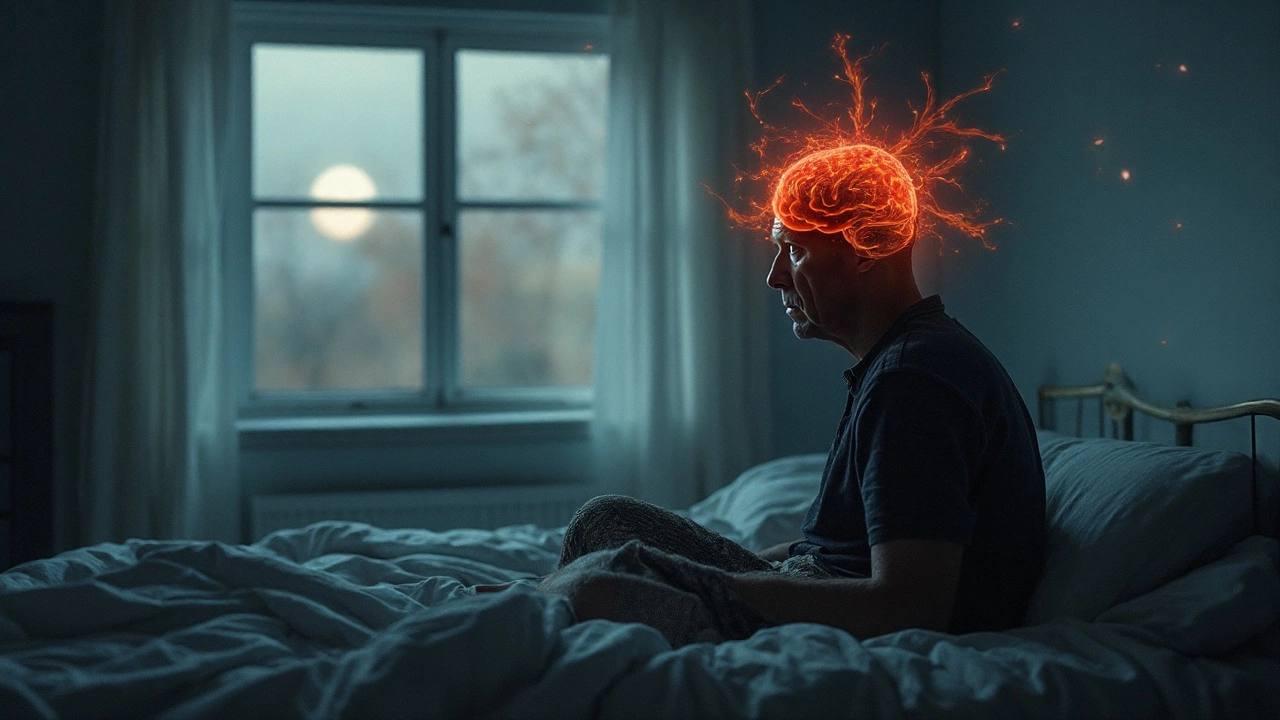Sleep disorders are a group of medical conditions that disturb normal sleep patterns, leading to poor quality or insufficient sleep. They affect up to 30% of adults and are linked to mental‑health issues, cardiovascular disease, and impaired cognition. When these disturbances intersect with Post‑Traumatic Stress Disorder (PTSD), the result is a vicious cycle: trauma‑driven arousal fuels sleeplessness, and sleeplessness magnifies trauma‑related distress. This article breaks down that connection, highlights the most common sleep problems seen in PTSD, and offers practical treatment pathways.
Understanding PTSD
PTSD is a psychiatric condition that can develop after exposure to a life‑threatening event, such as combat, assault, or a natural disaster. Core symptoms include intrusive memories, avoidance, negative mood, and hyperarousal. According to the National Institute of Mental Health, roughly 7-8% of the U.S. population experiences PTSD at some point.
Hyperarousal translates into a constantly “on‑edge” nervous system, which is a perfect breeding ground for sleep disorders. The brain’s alarm system-centered around the amygdala-fails to shut down at night, leading to fragmented sleep and vivid nightmares.
Key Sleep Disorders Linked to PTSD
Three sleep disturbances show the strongest epidemiological link to PTSD:
- Insomnia is difficulty falling or staying asleep, reported by 70-90% of PTSD patients.
- Nightmares are frightening, trauma‑related dreams that awaken the sleeper, affecting roughly 50% of those with PTSD.
- REM Sleep Behavior Disorder (RBD) involves acting out dreams due to loss of REM atonia; it is less common but markedly prevalent (about 15%) in combat‑related PTSD.
Neurobiological Bridge: Why Sleep Trouble Worsens PTSD
The brain regions that regulate fear and memory-namely the amygdala and the emotional alarm system-remain hyper‑active when sleep is fragmented. Simultaneously, the hippocampus, which consolidates episodic memory, shrinks in volume after chronic insomnia, impairing the brain’s ability to differentiate past trauma from present safety cues.
Elevated cortisol, the stress hormone, follows a disrupted circadian rhythm in both insomnia and PTSD. Higher nocturnal cortisol spikes keep the hypothalamic‑pituitary‑adrenal (HPA) axis on high alert, perpetuating flashbacks and hypervigilance.
Comparing the Sleep Disorders Most Common in PTSD
| Disorder | Typical PTSD Symptom | Prevalence in PTSD | First‑line Treatment |
|---|---|---|---|
| Insomnia | Difficulty falling/staying asleep | 70-90% | CBT‑I (Cognitive Behavioral Therapy for Insomnia) |
| Nightmares | Trauma‑related vivid dreams | ≈50% | Prazosin or imagery rehearsal therapy |
| REM Sleep Behavior Disorder | Acting out violent dreams | ≈15% | Melatonin or clonazepam; safety measures |

Evidence‑Based Treatments That Target Both Sleep and PTSD
When sleep problems are addressed directly, PTSD outcomes improve dramatically. Below are the most robust interventions:
- Cognitive Behavioral Therapy for Insomnia (CBT‑I) is a structured, short‑term therapy that reshapes sleep habits and thoughts about sleep. Randomized trials show a 40% reduction in insomnia severity and a 30% drop in PTSD intrusive symptoms.
- Prazosin is an alpha‑1 blocker that dampens the sympathetic surge during REM sleep, reducing nightmare frequency by up to 60% in combat veterans.
- Imagery Rehearsal Therapy (IRT) teaches patients to rewrite distressing dream scripts while awake, cutting nightmare distress by half.
- Integrated approaches combine prolonged exposure therapy with sleep‑focused CBT, offering synergistic gains in both fear extinction and sleep consolidation.
Medication should always be paired with behavioral strategies; monotherapy rarely resolves the underlying hyperarousal loop.
Practical Checklist for Clinicians
- Screen every trauma survivor for insomnia, nightmares, and abnormal REM behaviors using validated tools (e.g., ISI, PSQI, CAPS‑5 night‑mare item).
- Assess cortisol rhythm with salivary samples if chronic hyperarousal is suspected.
- Prioritize CBT‑I before prescribing sleep‑affecting medications.
- If nightmares dominate, start prazosin at 1mg nightly and titrate up to 10mg as tolerated.
- For REM sleep behavior disorder, ensure a safe sleep environment (remove sharp objects, use a bedside mat) and consider melatonin 3mg.
- Re‑evaluate PTSD symptom severity after 8‑12 weeks; adjust therapy based on sleep response.
Related Concepts and Next Steps
Understanding the sleep‑PTSD link opens doors to adjacent topics such as trauma‑informed care, mindfulness‑based stress reduction (MBSR), and the role of circadian rhythm therapy in stabilizing cortisol. Readers interested in deeper neurobiology can explore how glutamate signaling contributes to hyperarousal. Future articles will cover “How Mindfulness Improves Sleep in PTSD” and “Pharmacogenomics of PTSD‑Related Insomnia”.
Treating insomnia alone rarely eliminates PTSD, but it can significantly lower symptom severity. Studies show that patients who complete CBT‑I experience up to a 30% reduction in intrusive thoughts, making other PTSD therapies more effective. Nightmares occur during REM sleep, are vividly remembered, and often contain trauma content. Night terrors happen in non‑REM stages, involve abrupt awakening with intense fear, and are rarely recalled. PTSD is linked primarily to nightmares. Melatonin is generally safe and can improve sleep onset. In RBD, low‑dose melatonin (2-3mg) may reduce abnormal REM activity without the side‑effects of benzodiazepines, though a sleep‑environment safety plan remains essential. Many veterans report noticeable reduction within one to two weeks of reaching an effective dose (5-10mg). Full benefit may take up to a month, and dose adjustments are often needed based on blood pressure tolerance. Yes. Even when PTSD symptoms are mild, sleep problems can emerge early and predict chronicity. A brief questionnaire (e.g., ISI) takes under five minutes and guides timely referral to sleep specialists.Frequently Asked Questions
Can treating insomnia cure PTSD?
What’s the difference between a nightmare and a night terror?
Is melatonin safe for PTSD patients with REM sleep behavior disorder?
How quickly does prazosin work for nightmares?
Should I screen for sleep disorders in all trauma survivors?
